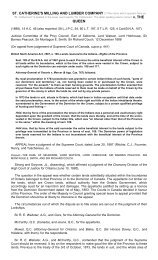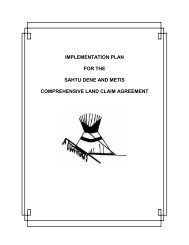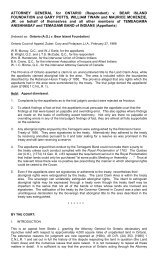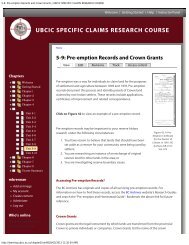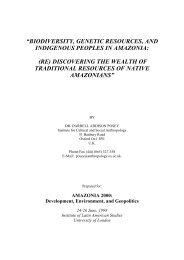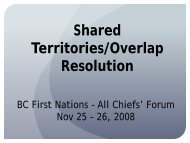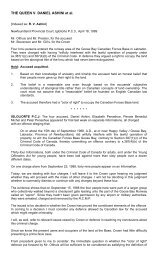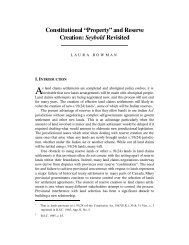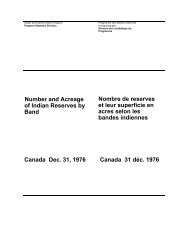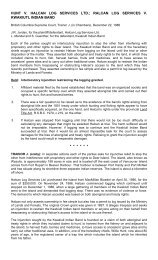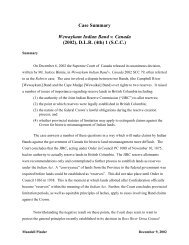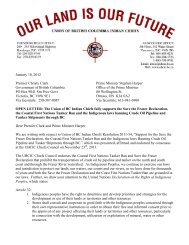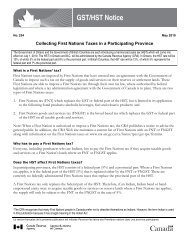ATTORNEY-GENERAL OF ONTARIO v. FRANCIS ET AL.
ATTORNEY-GENERAL OF ONTARIO v. FRANCIS ET AL.
ATTORNEY-GENERAL OF ONTARIO v. FRANCIS ET AL.
- No tags were found...
Create successful ePaper yourself
Turn your PDF publications into a flip-book with our unique Google optimized e-Paper software.
the defendants interested under licenses issued by the Government of the Province of Ontario.One does not readily perceive any sufficient reason for making persons claiming under licensesfrom the Government of Ontario parties defendant in the action, for it could scarcely have beenexpected that in matters of so great importance as are involved in the action substantial andmaterial relief could properly be granted in favor of some defendants against other defendantswithout any pleadings between them or any specific issues being raised by one or any of themagainst the other or others of them, and so far as any of the defendants might appear to beentitled to any relief against the plaintiff, this could not be obtained in this action, or, as wascontended, and I think rightly, in any way except by a petition of right.Besides the relief that I have already mentioned, the plaintiff asks that it may be declared thatthe defendants, the Francis's and Rochon, have no legal rights in respect of the timber cut fromand on any part or portion of the area covered by the above-mentioned timber limits, and that thetimber that had been cut should be delivered up to the plaintiff, also an injunction against theremoval of the same as well as an order for the payment of the damages alleged to have beensustained.The plaintiff asks, in addition to the foregoing, that the defendant by the Attorney-General of theDominion of Canada may be restrained from laying out or interfering with the lands as the reservefor the Indians on the timber limits before mentioned, or any part thereof, and that the true localityof the Indian reserve described by the treaty, mentioned in the second paragraph of the statementof claim, be declared, and such directions given as may be thought proper.This treaty was made with the Indians inhabiting the eastern and northern shores of LakeHuron, from Penetanguishene to Sault Ste. Marie, and thence to Botchewaning Bay, on thenorthern shore of Lake Superior, together with the islands in these lakes opposite to the shoresthereof, and inland to the height of land which formed the southern boundary of the territorycovered by the charter of the Hudson's Bay Company, whereby the whole of such territory, saveand except the reservations set forth in the schedule to the treaty annexed, was surrendered andceded to Her Majesty, Her Heirs and Successors forever. This treaty was made in the year 1850,and is known as the "Robinson-Huron Treaty", the representative of Her Majesty in the treatyhaving been the late Honorable William B. Robinson.The treaty was signed and executed by Mr. Robinson and a large number of chiefs and headmen of the Indians, and in the schedule are mentioned seventeen reserves or reservations tochiefs and their respective bands of Indians. It provides that these reservations should be heldand occupied by the chiefs and their tribes, in common for their own use and benefit, and thatshould the chiefs and their respective tribes at any time desire to dispose of any such reservationsor of any mineral or other valuable productions thereon, the same should be sold or leased at theirrequest by the Superintendent-General of Indian Affairs for the time being, or other officer havingauthority so to do, for their sole benefit and to their best advantage.The reserve mentioned in the plaintiff's statement of claim and in respect of which the presentdifficulty and contention seems principally to have arisen, is the one No. 6 in this schedule and isthus mentioned therein: "Sixth, Shawenakishick and his band, a tract of land now occupied bythem and contained between two rivers, called Whitefish and Wanabitaseke, seven miles inland."Other than this there does not seem to have been at the time any other or further description ofthis reserve, and the others of the seventeen reserves are mentioned or described in the scheduleto the treaty in a manner somewhat similar, if not in the same manner, or at all events with greatbrevity. The evidence shows that it was intended and that it was promised to the Indians that thereserves should soon after the treaty be surveyed by the Crown and their true boundaries markedout, and I think it sufficiently appears that it was understood that when the Crown surveyors weresent for the purpose of making the surveys, the Indians were to point out and show to them thelands that they claimed and had claimed as such reservations.Many years ago these reserves were surveyed by the Crown, as was contemplated, exceptingthis one, No. 6 in the schedule and, as was stated at the trial, another one. The reason why all thesurveys were not completed at the same time does not appear in the evidence, but it was said thatthe survey stopped before completion for a reason personal to the Crown Surveyor who wasengaged in the work.In the year 1872 the Executive Government for the Province of Ontario, for the purposes oftimber sales in the region or tract ceded by the above-mentioned treaty, projected on a plan intoan area of six square miles each, berths which were numbered and sold according to theregulations prescribed by the Government of the province on the 15th day of October in that year,and among others then sold were the several berths aforesaid and in pursuance of such saleslicenses to cut timber on the timber berths were in consideration of certain payments, and to



